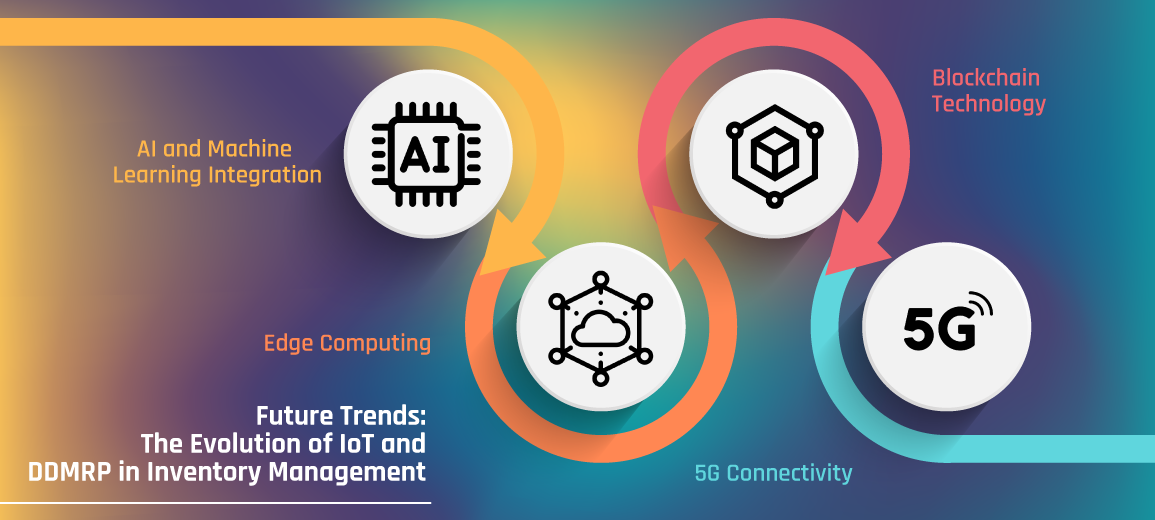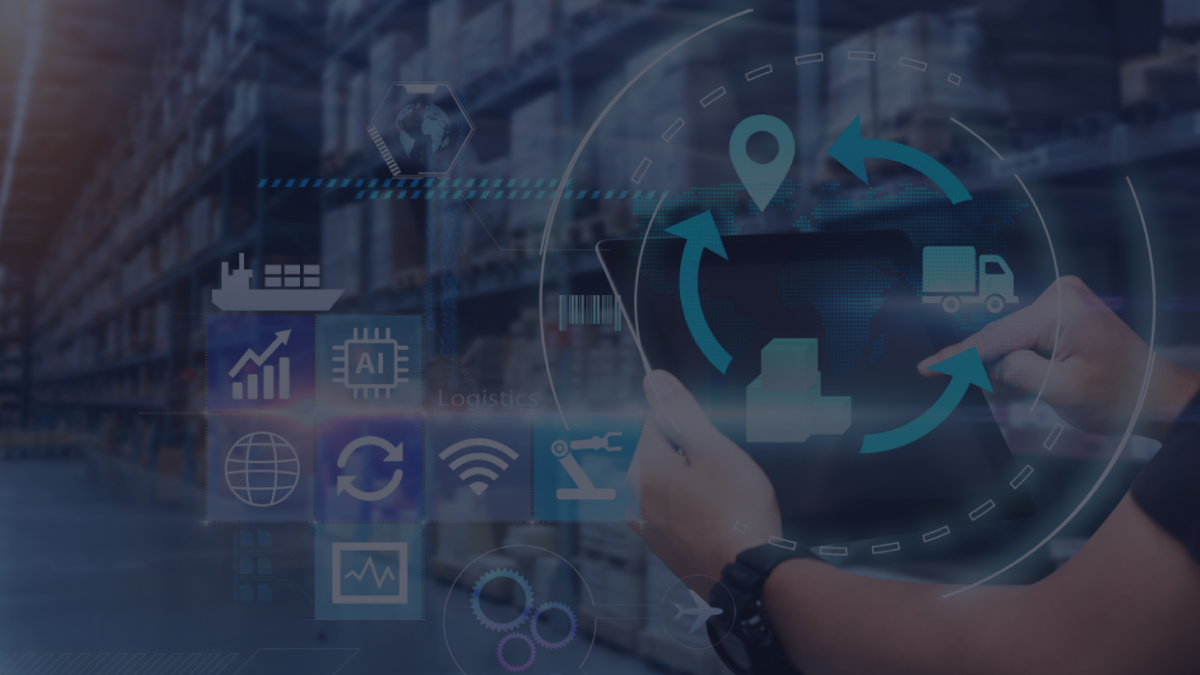
Boosting DDMRP Transparency and Efficiency with Blockchain Technology
August 19, 2024
Improving Supply Chain Collaboration through DDMRP Implementation
September 6, 2024In the era of Industry 4.0, where digital transformation is reshaping every facet of business operations, inventory management is no exception. The convergence of the Internet of Things (IoT) and Demand Driven Material Requirements Planning (DDMRP) is paving the way for a new paradigm in inventory management – one that is characterised by real-time visibility, enhanced accuracy, and improved operational responsiveness.
Understanding DDMRP in the Context of Inventory Management 4.0
DDMRP stands in stark contrast to conventional inventory management practices, which often rely on forecasting, leading to potential inaccuracies and inefficiencies. By focusing on real-time demand signals, DDMRP empowers businesses to maintain optimal inventory levels, minimising the risks of both overstocking and stockouts.
A key tenet of DDMRP is the strategic placement of inventory buffers throughout the supply chain. These buffers act as shock absorbers, enabling businesses to navigate the inherent volatility of market demand and the potential disruptions within the supply chain. By strategically positioning these buffers at critical points, DDMRP ensures that businesses can respond effectively to fluctuations in demand and unforeseen events, maintaining a consistent flow of goods to customers.
DDMRP harnesses the power of advanced technologies and data analytics to achieve unprecedented levels of responsiveness and agility. Real-time data on sales, inventory levels, and supply chain conditions are collected and analysed, providing businesses with actionable insights for informed decision-making. This data-driven approach allows for dynamic adjustments to inventory buffers and replenishment strategies, ensuring that inventory levels remain aligned with actual market needs.
The Role of IoT in Revolutionising Inventory Visibility
In the modern, fast-paced business world, having precise and up-to-the-minute knowledge about your inventory is no longer a luxury – it’s a necessity. This is where the Internet of Things (IoT), a network of interconnected devices capable of collecting and exchanging data, steps in to transform inventory visibility.
Traditionally, keeping track of inventory was a labour-intensive, time-consuming, and often inaccurate process. It involved manual counts, paper trails, and a significant margin for human error. The IoT revolutionises this by providing real-time visibility into inventory levels, location, and condition, enabling businesses to make informed decisions based on accurate and current data.
Real-Time Tracking and Monitoring
At its core, the IoT empowers businesses to track and monitor their inventory in real-time. By equipping inventory items with IoT sensors, companies can follow their movement throughout the supply chain, from the moment they leave the supplier’s warehouse to the instant they reach the customer’s doorstep. This not only helps in preventing loss or theft but also enables businesses to optimise their supply chain operations by identifying bottlenecks and inefficiencies.
Furthermore, IoT sensors can monitor the storage conditions of inventory items, such as temperature, humidity, and light exposure. This is particularly crucial for perishable goods or items sensitive to environmental conditions. By receiving alerts when conditions deviate from the ideal range, businesses can take corrective action to prevent spoilage or damage, thus minimising losses and ensuring product quality.
![]()
Predictive Analytics and Proactive Management
The power of IoT doesn’t stop at real-time tracking and monitoring. The data collected by IoT sensors can be leveraged to generate predictive analytics, enabling businesses to anticipate potential issues before they occur. For instance, by analysing historical data on product movement and storage conditions, IoT systems can predict when an item is likely to go out of stock or become damaged.
This predictive capability allows businesses to adopt a proactive approach to inventory management. Instead of reacting to stockouts or product damage, they can take preemptive measures to replenish inventory or adjust storage conditions, ensuring that they always have the right products in the right quantity and in the right condition to meet customer demand.
Integrating IoT with DDMRP for Real-Time Inventory Insights
The convergence of the Internet of Things (IoT) and Demand Driven Material Requirements Planning (DDMRP) is ushering in a new era of real-time inventory insights, empowering businesses to make smarter, data-driven decisions.
The Power of Synergy: IoT and DDMRP
The integration of IoT and DDMRP represents a powerful synergy that transcends the limitations of traditional inventory management approaches. IoT, with its network of interconnected devices and sensors, provides a continuous stream of real-time data on inventory levels, location, and condition. This wealth of information, when fed into the DDMRP system, enables businesses to dynamically adjust their inventory buffers based on actual demand and supply chain conditions.
Dynamic Inventory Buffer Adjustments
One of the core principles of DDMRP is the strategic placement of inventory buffers throughout the supply chain. These buffers act as shock absorbers, mitigating the risks associated with demand variability and supply chain disruptions. However, in a traditional setup, these buffers are often static and based on historical data or forecasts, which may not accurately reflect the current market realities.
The integration of IoT with DDMRP allows for dynamic adjustments to these inventory buffers. As IoT sensors provide real-time data on inventory levels and movement, the DDMRP system can recalculate buffer sizes based on actual demand and supply chain conditions. This ensures that inventory levels are always aligned with market needs, minimising the risk of stockouts or overstocking.
Real-Time Demand Visibility
IoT sensors embedded in products or shelves can also provide real-time visibility into demand patterns. This information can be invaluable for businesses in adjusting their production schedules, replenishment strategies, and marketing campaigns. By understanding customer preferences and buying behaviour in real-time, businesses can make more informed decisions that drive sales and improve customer satisfaction.

Data-Driven Decision Making
The integration of IoT and DDMRP creates a data-rich environment that empowers businesses to make more informed and strategic inventory decisions. By analysing the vast amounts of data generated by IoT sensors, businesses can identify trends, patterns, and opportunities for optimization. This leads to improved efficiency, reduced costs, and enhanced competitiveness.
Key Benefits of IoT-Enabled DDMRP: A Paradigm Shift in Inventory Management
The fusion of the Internet of Things (IoT) with Demand Driven Material Requirements Planning (DDMRP) is transforming inventory management, offering a multitude of benefits that enhance efficiency, reduce costs, and foster greater agility across the supply chain. Let’s delve deeper into these advantages:
Enhanced Inventory Accuracy: The End of Guesswork
In traditional inventory management, manual counts are often the norm, leading to inaccuracies due to human error or oversight. IoT sensors, strategically placed throughout the warehouse or supply chain, provide real-time data on inventory levels. This eliminates the need for time-consuming manual counts, ensuring that businesses have an accurate, up-to-the-minute picture of their inventory. This accuracy translates into better decision-making, reduced stockouts, and improved customer satisfaction.
Improved Operational Responsiveness: Adapting to Change at Lightning Speed
Market conditions are constantly changing, and businesses need to be able to adapt quickly to stay ahead of the curve. IoT-enabled DDMRP provides real-time visibility into both inventory and demand, enabling businesses to respond swiftly to fluctuations in the market. Whether it’s a sudden surge in demand or a disruption in the supply chain, businesses can make informed decisions to adjust their inventory buffers and production schedules, ensuring that they can meet customer needs without incurring excessive costs.

Optimising Inventory and Minimising Waste
Inventory carrying costs can be a significant drain on a company’s resources. Overstocking ties up capital and increases the risk of obsolescence, while stock outs lead to lost sales and dissatisfied customers. IoT-enabled DDMRP helps to optimise inventory levels by aligning them with actual demand, minimising the risk of both overstocking and stockouts. Furthermore, by providing real-time visibility into inventory conditions, IoT sensors can help to identify and prevent spoilage or damage, reducing waste and further lowering costs.
Optimised Supply Chain Performance: Collaboration and Transparency
A well-functioning supply chain requires seamless collaboration and communication between suppliers, manufacturers, and distributors. The integration of IoT and DDMRP creates a more transparent and efficient supply chain by providing all stakeholders with access to real-time data on inventory levels, demand, and supply chain conditions. This shared visibility fosters better collaboration, enabling all parties to work together to optimise inventory flows, reduce lead times, and improve overall supply chain performance.
Challenges and Considerations in Implementing IoT-DDMRP Integration
While the integration of IoT and DDMRP offers a promising vision for inventory management, it’s not without its hurdles. Businesses must be prepared to navigate several challenges and considerations when implementing this integration:
- Cost of Implementation: The upfront investment in IoT sensors, network infrastructure, and data analytics capabilities can be significant, especially for large-scale deployments. Businesses need to carefully weigh these costs against the potential benefits and long-term ROI.
- Data Security and Privacy: IoT devices generate vast amounts of data, which can be vulnerable to cyberattacks and privacy breaches. Robust security measures, such as encryption and access controls, are essential to protect sensitive inventory and supply chain data.
- System Integration: Integrating disparate IoT and DDMRP systems can be complex. Ensuring seamless data flow, compatibility between different technologies, and effective communication between systems requires careful planning and technical expertise.
- Change Management: Implementing IoT-DDMRP integration often involves changes to existing processes and workflows. It’s crucial to address any resistance to change through effective communication, training, and support for employees to ensure a smooth transition.
- Scalability: As businesses grow and their supply chains become more complex, the IoT-DDMRP infrastructure needs to scale accordingly. Businesses need to choose scalable technologies and platforms that can accommodate future growth and expansion.
Future Trends: The Evolution of IoT and DDMRP in Inventory Management
The future of inventory management is poised for exciting advancements as IoT and DDMRP continue to evolve and converge. Here are some anticipated trends:
- AI and Machine Learning Integration: Artificial intelligence and machine learning will play a pivotal role in enhancing the capabilities of IoT-DDMRP systems. These technologies will enable more sophisticated demand forecasting, predictive analytics for inventory optimization, and automated decision-making to streamline operations.
- Edge Computing: The proliferation of IoT devices will lead to a surge in data volume. Edge computing, where data processing occurs closer to the source, will reduce latency, improve real-time responsiveness, and enable localised decision-making, especially in remote or distributed environments.
- Blockchain Technology: Blockchain can enhance transparency and traceability across the supply chain. By providing an immutable record of transactions and product movements, it can mitigate risks of counterfeiting, fraud, and compliance issues, leading to greater trust and collaboration among stakeholders.
- 5G Connectivity: The rollout of 5G networks will offer faster data speeds and lower latency, enabling real-time communication and data exchange between IoT devices and DDMRP systems. This will empower businesses with even greater responsiveness and agility in managing their inventory.

Conclusion: Embracing IoT for Smarter, More Efficient Inventory Management
The integration of IoT and DDMRP represents a major step forward in the evolution of inventory management. By providing real-time visibility into inventory and demand, this powerful combination enables businesses to make smarter, more informed decisions that lead to improved efficiency, reduced costs, and enhanced customer satisfaction. In the era of Inventory Management 4.0, embracing IoT is not just an option, but a necessity for businesses that want to stay ahead of the curve.
Reach out to explore how IoT can transform your inventory management with real-time insights in a DDMRP framework.





